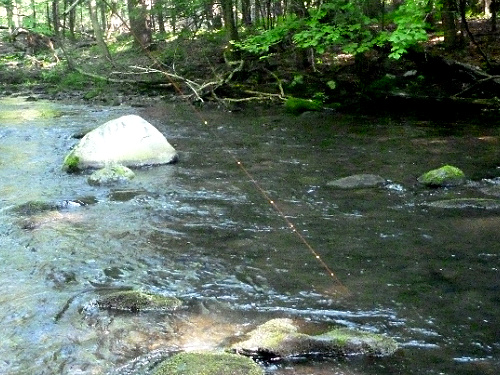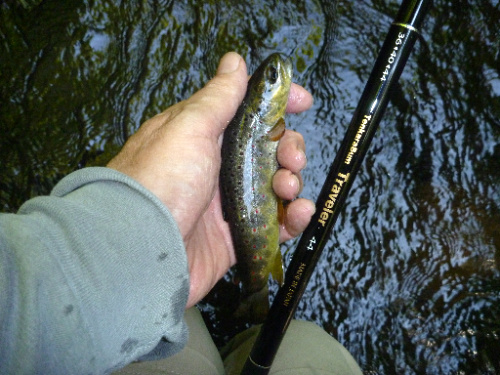Keiryu Trip Report - 7-19-20
Rethinking Tenjo Lines
This report is mostly a follow-up to the Small Stream Keiryu report of 7-9-20. On that trip I fished with Suntech Kurenai HM45R and HM39R seiru rods, which proved very well suited to the 5-8" fish I caught. What did not prove so well suited was the keiryu line consisting of 7X fluorocarbon tippet all the way from the rod tip to the hook.
I generally use a hi-vis Tenjo line as the uppermost section of a three section keiryu line. The length of my Tenjo lines range from 3 to 6 feet long (3 feet for a 14 foot rod, 4 feet for a 17 foot rod and 6 feet for a 21 foot rod). The hi-vis Tenjo line provides two benefits: 1) it is thicker than the middle portion of a keiryu line, making it less likely to tangle around the rod tip if you miss a hook set, and 2) being hi-vis, it leads your eye in the direction to your markers, making them easier to spot.
On the July 9 trip, with no Tenjo line to point the way, the markers were often hard to find when the bait first hit the water. More than once I missed the first quarter of the drift before I spotted them. I eventually changed my marker spacing from the 2-3 inches between markers, which I have used for the last few years, back to the 6-8 inch spacing I used when I first started keiryu fishing. The shorter spacing makes the markers easier to follow once you spot them, but the wider spacing makes it a bit easier to spot at least one of them during the cast or at the very start of the drift.
 Hi-vis line with keiryu markers
Hi-vis line with keiryu markersFor this trip, I had wondered if using a keiryu line made from hi-vis spinning line rather than a clear tippet would be easier to see. Logically, it should be, but the line I used (Varivas Bait Finess Nylon 3 lb) is the same diameter as 6X tippet material, and I was concerned that the line would be so thin that even if it was "hi-vis" it wouldn't be hi-vis enough to actually see. I had once before tried "hi-vis" fluorocarbon spinning line the diameter of 5X, and the line wasn't bright enough to be a big help.
Nylon is brighter, and the Varivas Bait Finess Nylon is incredibly bright, so even the .005" diameter line was clearly visible. I had made the line with six widely spaced markers, but the line was visible enough that the increased number of markers and the wide spacing weren't necessary.
Going forward, though, I would not make the line exactly as I did for this trip. I would still use markers for strike detection, as I think it is easier to see a strike that pulls the markers straight down than one that pulls a nearly vertical hi-vis line straight down.
I would still recommend a middle section of clear line (to which the markers are attached) that is stronger than the lowest section (to which the hook and split shot are attached). Keeping hi-vis line well above the surface follows the advice of Rob Worthing, who has reported that large, heavily pressured fish are alerted by the hi-vis sighter material often used in Euro nymphing. He has caught previously uncatchable fish, but only after switching to a low-vis line and a white sighter rather than a fluorescent orange or chartreuse sighter.
In the past, I have recommended that the lowest section of a keiryu line should be equal to the depth of the shallowest water you expect to fish. You want all the line under the surface to be as light as possible for better drifts. However, you also want your lowest marker to be only a bit above the surface and you cannot slide a marker knot down past the knot or tippet ring that connects the lowest section to the middle section. The middle section thus has to go almost all the way down to the water's surface when you are fishing shallow water.
What I would change from my prior commentary on making keiryu lines is the length of the Tenjo line. I had recommended only 3 to 6 feet of Tenjo line, depending on rod length. The advantage of a shorter Tenjo line is that more of your line can be very light weight material. Even with a section of Tenjo line pointing the way towards the markers, though, if the markers still 10 to 12 feet away from the end of the Tenjo line they are often still hard to spot until well into the drift (by which time you might already have a deeply hooked fish if you had slack in the line and you didn't set the hook early enough). I think a slightly heavier line, caused by the longer Tenjo line, might be a valuable trade-off given that the longer Tenjo line enhances visibility.
If a long, highly visible Tenjo line allows you to find the markers immediately, the markers can be spaced fairly close together, which does make them easier to watch. Just as you cannot slide them down past the knot joining the lower and middle sections, you cannot slide them up past the knot joining the middle and upper sections. Thus, the top end of the middle section has to be a little higher than the depth of the deepest water you expect to fish that day.
If you go from fishing water that is 1 foot deep to fishing water that is 5 feet deep, you need to be able to raise your markers 4 feet to keep the lowest one above the surface. If the distance from your lowest marker to your highest marker is 1 foot (four markers at 4 inch intervals), the distance from your hook to the top end of your middle section has to be a bit over 6' but it doesn't have to be any longer than that. If you are fishing with a 17' rod, your Tenjo line could be 10' long instead of 3' long.
The bottom of your Tenjo line always would be within a few feet of your markers. You would never again have to squint and search to find them. Not only would you be ready for an instantanious hit the moment your bait hit the water, you would also be able to raise your rod tip as necessary to make sure the markers were never in the water.
The fluorocarbon Sunline Tenjo line is priced almost exactly the same as the Varivas Fluorocarbon tippet material, so a longer Tenjo line and shorter fluorocarbon middle section adds only a few pennies to the cost of your keiryu line. If it helps you catch one more fish it is surely worth it.
 The TenkaraBum Traveler 44 is a good keiryu rod for small streams.
The TenkaraBum Traveler 44 is a good keiryu rod for small streams.I think the Sunline Tenjo line, which is quite bright for fluorocarbon, would be better than the Bait Finess Nylon spinning line. Fluorocarbon is denser than nylon, and even with lines that thin, wind resistance is a factor. Still, if you don't have any Tenjo line, my recent trip proves that you can use a light hi-vis spinning line as the uppermost portion of a keiryu line.
TenkaraBum Home > Keiryu Trip Reports > Keiryu Trip Report 7-19-20
“The bitterness of poor quality remains long after the sweetness of low price is forgotten” - Benjamin Franklin
"Be sure in casting, that your fly fall first into the water, for if the line fall first, it scares or frightens the fish..." -
Col. Robert Venables 1662
As age slows my pace, I will become more like the heron.
We've all had situations where seriously chewed up flies kept catching fish after fish after fish. It is no sin to tie flies that come off the vise looking seriously chewed up.
Warning:
The hooks are sharp.
The coffee's hot.
The fish are slippery when wet.
Beware of the Dogma
Seriously, all the hooks sold on TenkaraBum.com, whether packaged as loose hooks or incorporated into flies, are sharp - or as Daiichi says on their hook packages, Dangerously Sharp. Some have barbs, which make removal from skin, eyes or clothing difficult. Wear eye protection. Wear a broad-brimmed hat. If you fish with or around children, bend down all hook barbs and make sure the children wear eye protection and broad-brimmed hats. Be aware of your back cast so no one gets hooked.
Also, all the rods sold on TenkaraBum.com will conduct electricity. Do not, under any circumstances, fish during a thunder storm. Consider any fishing rod to be a lightning rod! Fishing rods can and do get hit by lightning!
What's in stock?
Kurenai II AR 30F
Kurenai II AR 33F
Kurenai II AR 39F
TenkaraBum 33
TenkaraBum 36
Furaibo TF39
Furaibo TF39TA
Nissin Oni Tenkara Line
If you enjoy spin fishing or baitcasting please visit my sister site Finesse-Fishing.com.


